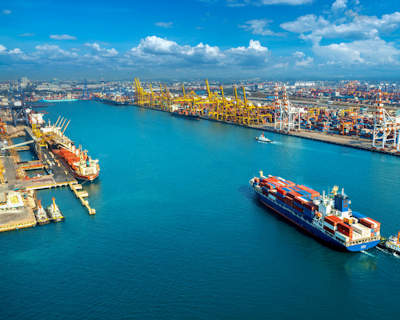The Rise of Smart Ports: How Technology is Revolutionizing Port Operations

In an increasingly connected world, the heartbeat of global trade – our ports – are undergoing a transformation as profound as the shift from sail to steam. As technology evolves, the concept of the traditional port is being redefined, transitioning from mere points of cargo transfer to becoming advanced hubs of digital logistics and innovation. Enter the era of “Smart Ports”.
* Please send feedback/suggestions to editor @ shipuniverse.com
Introduction to Smart Ports
The term “smart” is often associated with the integration of digital technology and connectivity into traditional systems, and ports are no exception. A smart port harnesses various technological advancements to optimize, automate, and enhance its operations. This not only translates to increased efficiency but also ensures sustainability, security, and resilience in the face of global challenges.
Digital Infrastructure
Central to the transformation into smart ports is the establishment of a robust digital infrastructure. The foundation lies in the deployment of the Internet of Things (IoT) sensors across port facilities. These sensors collect vast amounts of data – from the condition of equipment, weather patterns, water currents, to the real-time position of ships and containers. When complemented with 5G connectivity, this data can be transmitted in real-time, ensuring that decisions are made promptly and based on accurate information.
Cloud computing has further empowered ports, allowing them to store, process, and analyze the enormous amounts of data collected. With powerful data analytics, ports can predict trends, preempt challenges, and allocate resources more effectively.
Automation and Robotics
One of the most visible transformations in smart ports is the increasing deployment of automation and robotics. Automated container handling systems are replacing traditional manual processes. These systems can move cargo faster, more efficiently, and with fewer errors, resulting in shorter ship turnaround times and increased port capacity.
In addition to ground operations, the skies above the ports are also witnessing a change. Drones, equipped with high-resolution cameras and sensors, are now being used for tasks ranging from surveillance, inspection to even small cargo deliveries within the port premises.
Blockchain in Port Operations
Traditionally, port operations involved a labyrinth of paperwork. Today, blockchain technology is set to revolutionize this. Blockchain ensures a transparent, tamper-proof, and streamlined documentation process. Every stakeholder, from shipowners, freight forwarders, customs, to the end customer, can track the cargo’s journey, ensuring transparency and reducing the chances of fraud and delays.
Environmental Sustainability
In today’s eco-conscious world, the sustainability factor cannot be overlooked. Smart ports are at the vanguard of embracing green technologies. Electrified equipment is replacing older, fossil fuel-driven machinery, leading to reduced emissions within the port’s boundaries. Waste management solutions, powered by AI, are ensuring efficient recycling and disposal processes. Water quality monitoring systems are in place, making sure that port activities do not adversely impact marine ecosystems.
Moreover, with predictive analytics, ports can now optimize vessel traffic, reducing unnecessary idling and emissions from ships waiting to dock. Smart energy grids within the port can also ensure optimal energy consumption and even integrate renewable sources like solar and wind.
Security Enhancements
With the rise in digital integration, cybersecurity has become paramount. Ports are deploying advanced cybersecurity solutions to safeguard their digital assets against threats. AI-driven surveillance systems offer real-time threat assessment, ensuring not just digital but also physical security. Biometric systems at access points further enhance security by ensuring only authorized personnel enter critical areas.
Furthermore, AI-powered anomaly detection can identify unusual patterns in data or operations, flagging potential threats or malfunctions before they escalate.
Challenges & Considerations
The path to becoming a smart port, while promising, is not devoid of challenges. The initial investment required for technological overhauls can be substantial. There’s also the pressing issue of integrating new technologies with legacy systems without causing operational disruptions.
Another significant concern is the potential for job displacements. Automation, while efficient, might reduce the need for certain manual roles. It’s vital for port authorities and governments to foresee this change and offer retraining and reskilling opportunities for affected workers.
With smart ports taking the helm, the maritime industry is navigating into a future that promises increased efficiency, resilience, and sustainability. As technology continues to advance, there’s no doubt that the ports of tomorrow will be even smarter, serving as lighthouses guiding the global trade industry.

Do you have a Maritime Product or Service that may be of interest to Shipowners? Tell us about it here!
Do you have feedback or insights? Please reach out to editor @ shipuniverse.com



